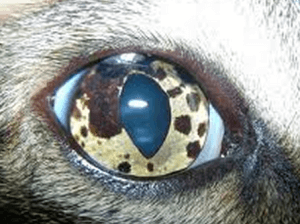What Are the Spots On Your Cat’s Iris?
 If you’re like me and you have an older cat, you know that your little ball of fur will possibly start to show signs of his age through illnesses, or just lack of energy. What you may not know, is that older cat’s with yellow eyes are more likely than other types to contract Melanocytoma, the spotting of the iris. The iris is the colored portion of the cat’s eye.
If you’re like me and you have an older cat, you know that your little ball of fur will possibly start to show signs of his age through illnesses, or just lack of energy. What you may not know, is that older cat’s with yellow eyes are more likely than other types to contract Melanocytoma, the spotting of the iris. The iris is the colored portion of the cat’s eye.
These spots can be brown or black and be of any size and not cause immediate harm to your pet. However, if these spots begin to change shape, grow or multiply in number, you will have to bring your cat in to see a vet immediately.
Melanocytoma is the growth of abnormal tissue in or around your act’s eye, resulting in brown or black spots. Melanosis usually affects cats 12-14 years or older, but in rare cases can affect cats as young as 6 years. Cats can live comfortably for years with this condition without ever developing more serious symptoms or complications, but you should still keep an eye on the spots and take your cat in for regular check ups with the vet. As long as these spots stay flat on the iris they are benign.
Luckily, most cases of iris melanosis do not undergo malignant change to melanoma. In fact, a cat with progressive iris melanosis is more likely to develop glaucoma from infiltration and obstruction of the drainage angle (the area in the eye where the intraocular fluid drains) than he is to develop distant metastasis.
In the event that the spots increase in number or size, or change from their flat position and begin to appear bumpy, the disease has progressed to the next stage and have most likely become malignant. That means that they have become Melanoma and are cancerous and in need of immediate treatment. If left untreated, the cancer cells from the eye can detach and become lodged elsewhere in the body, spreading the cancer to another organ.
When Melanoma is caught early the treatment can successfully remove the cancerous cells. This is accomplished through the use of a laser by a veterinary surgeon. However, in some cases complete extraction of the eye may be necessary to stop the disease form progressing (removal of the eye).
Melanosis can also be caused by corneal ulcers or trauma. It is also possible for erosion to cause dark spots in the clear portion of cat’s eyes, according to Animal Eye Care. If your cat has been engaging in play or combat with another cat, it is possible for a scratch to the eye to become infected resulting in the dark spots. It is also possible for something to become lodged underneath the eyelid slicing the cornea and resulting in this sort of infection as well.
Should you notice something under your cat’s eyelid, do not try to remove it yourself, bring your cat to a vet immediately for treatment. You can further damage your cat’s eye trying to remove particles from under their eyelids.
Infections such as conjunctivitus can also cause spots in your cat’s eye. These are defined by squinting, discharge, and local inflammation. Treatment for these viruses depend on the type of infection or bacteria, most likely though your vet will prescribe eye drops or ointment to clear up any virus your cat may have caught. Remember when administering the medicine to give the complete dosage for the entire time, even if the eye heals. You need to keep giving your kitty the medicine until it is all gone.










 Website Created by TCP Global Solutions
Website Created by TCP Global Solutions